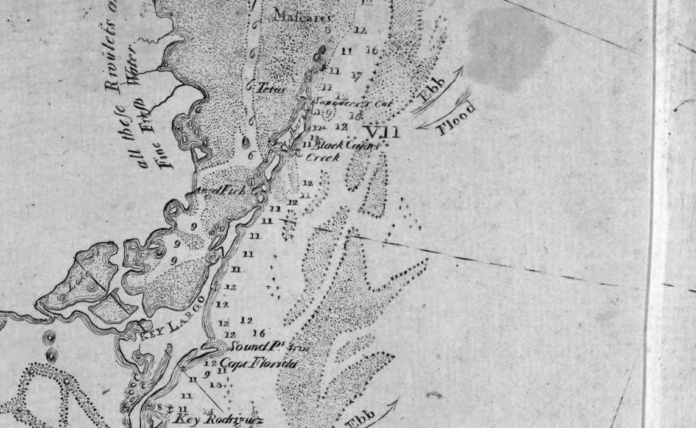“Maps of East and West Florida” was published in 1775. Among the features identified in this collection is a map of the Northern Keys that identifies a body of water flowing between Elliott Key and Old Rhodes Key. The mapmaker chose a legendary name for it.
The man who did it was Bernard Romans, and he plays an interesting role in the history of piracy in the Florida Keys. Bernard Romans was born in 1720, just two years after the death of perhaps the most notorious pirate to have ever lorded over the West Indies, the one and only Captain Edward Teach. He was better known as Blackbeard.
While Romans is perhaps best remembered for his maps, it was not the only way he had historically made a buck. He was also a professional sailor. In 1761, Romans gained employment as a commodore in service of the king of England. Romans did not serve the government in the sole capacity of a commodore. He was also issued a letter of marque that allowed him to work as a privateer under the British flag.
Letters of marque were issued to sanction privateering. Working as a privateer was very much like working as a pirate. They essentially performed the same job and did so in the same conquering manner. A pirate attacked whom they wanted, and the captain and crew retained the entire prize. Pirates did what they wanted to do to whomever they wanted. They also kept everything they could wrap their fingers around for themselves.
On the other hand, a privateer was bound by government stipulations. For instance, privateers were only allowed to attack ships flying flags from countries where the host country was at war. The privateer captain working under the proclamation of a letter of marque was responsible for hiring and paying his crew out of his pocket. Also, the government issued a pirate tax for the right to act as privateers. Under the rules of the letter, in exchange for the right to attack ships at sea, a percentage of any prize the privateer was able to secure was given to the sponsoring government.
Privateering was not the only act of “piracy” Bernard Romans would commit. He also profited from the illegal transport of human cargo. By 1768, he had left his privateering days behind him and, it might be assumed, his days of smuggling human chattel. The English government appointed Romans as the deputy surveyor for the Southern District of the newly acquired Florida Territory.
The former Spanish property was deeded to the English under the 1763 Treaty of Paris, which signified the end of the French and Indian War. During this period, the territory was divided into eastern and western parts. West Florida consisted of the territory west of the Apalachicola River, and East Florida comprised the land east of the river and included the peninsula and the Florida Keys.
In the years following the transaction, Bernard Romans was hired to survey the coasts outlining both sides of the Southern District. Between 1770 and 1771, he was busy surveying the waters around South Florida. During this time, he charted Elliott Key, Old Rhodes Key, and the creek flowing between them. Romans decided to use the name Black Caesars Creek to identify it. Not satisfied with labeling just one feature with the Black Caesar name, he identified two. In addition to the creek flowing between the two islands, he named the rocky islet rising out in the middle of it Black Caesars Rock.
Black Caesar references the legendary pirate said to have lorded over the Straits of Florida from his Elliott Key lair for a decade, and what makes Romans’ declaration extraordinary is that it is not just that it is the first time that that piratical name was connected to the Florida Keys, but also it appears to be the first documented case of the name Black Caesar being memorialized in print.
The big question is why Romans chose that particular name. After all, one of the things that set Romans apart from other royally appointed surveyors was that most chose to mark their maps with proper English names or names of British origins. Romans, on the other hand, favored the use of colloquial identifiers.
It might have been that the locals he encountered during his survey called the creek, and the rock, Black Caesars, and that is why he chose the name and put it down in print. Based on his experience in the field of piracy, a pirate story would have likely interested him.
In next week’s column, we will explore the possible reasons the name Black Caesars Creek was chosen, its significance, and the role Romans’ choice has played in the history of piracy in the Florida Keys.




















